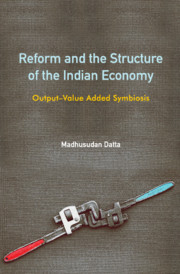Book contents
- Frontmatter
- Dedication
- Contents
- Tables
- Figures and Box
- Preface
- 1 Introduction: The Take-off
- 2 Growth and Structural Change since 1978–79: Issues in Measurement
- 3 Sectoral Shares in Indian GDP: How to Regard It?
- 4 Sectoral Growth: GVA–Output Dichotomy
- 5 Manufacturing Sector in the Indian Economy: Paradox of Growth and Stagnation
- 6 Growth and Sectoral GVA Adjustments
- 7 Demand for Intermediate Services
- 8 Linkages and Key Sectors in the Indian Economy
- 9 Conclusion: A Perspective of Indian Economic Growth
- References
- Index
9 - Conclusion: A Perspective of Indian Economic Growth
Published online by Cambridge University Press: 17 March 2020
- Frontmatter
- Dedication
- Contents
- Tables
- Figures and Box
- Preface
- 1 Introduction: The Take-off
- 2 Growth and Structural Change since 1978–79: Issues in Measurement
- 3 Sectoral Shares in Indian GDP: How to Regard It?
- 4 Sectoral Growth: GVA–Output Dichotomy
- 5 Manufacturing Sector in the Indian Economy: Paradox of Growth and Stagnation
- 6 Growth and Sectoral GVA Adjustments
- 7 Demand for Intermediate Services
- 8 Linkages and Key Sectors in the Indian Economy
- 9 Conclusion: A Perspective of Indian Economic Growth
- References
- Index
Summary
What's past is prologue.
—Inscription on the National Archives Building, Washington, DC, from The Tempest, ShakespearePast may be prologue, but which past?
—Henry Hu, quoted from Lowenstein (2000: ix)A Macroscopic View
India transitioned from a slow-growing to a decently growing (about 5 per cent per annum) economy in the second half of the 1970s but was temporarily pulled down by the devastating drought of 1979–80, an event that pushed the annual growth rate of the GDP 5.2 percentage points below zero. This severe external shock has influenced the break-point analysis of growth regimes. The 5-year moving average growth rate picked up in the next three years to reach the level achieved before the shock, and over the following three decades the average fell only narrowly below 5 per cent level in just two short stretches of three and two years respectively in the mid-1980s and early 1990s (Figure 2.1 in Chapter 2). But there were prolonged phases when the average remained above 6 or even 8 per cent; these phases were located in time after the big comprehensive reform of 1991. Naturally, much of the attention of observers is focused on this phase. The present study, however, concentrates on roughly three decades since 1978–79. The study exploits the rich information contained in the input–output transactions tables (IOTTs) of the Indian economy, apart from data available from other official sources; the IOTTs are available roughly at quinquennial intervals and our reference dates are often based on their availability. In 1980 sectoral relative shares were in conformity with the stylized facts of economic growth (as discussed in Chapter 3). The relative share of the manufacturing sector reached a peak in 1979–80, which, frustrating expectations, has not been surpassed in the subsequent decades. Also, from about that time onwards the country was on the lookout for new policy directions. So, from the point of view of analysis of structural change, the turn of the 1970s provide a vantage point in time.
Some observers maintain reservations regarding the reliability of the IOTTs of the Indian economy as these are produced after adjustments for statistical discrepancy between production and expenditure sides, though sources of data are the same for the IOTTs and the National Accounts Statistics (NAS).
- Type
- Chapter
- Information
- Reform and the Structure of the Indian EconomyOutput-Value Added Symbiosis, pp. 150 - 161Publisher: Cambridge University PressPrint publication year: 2020



